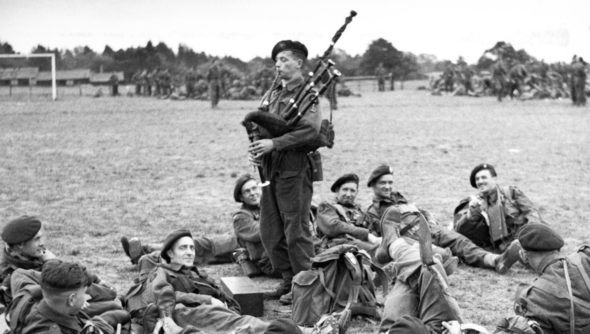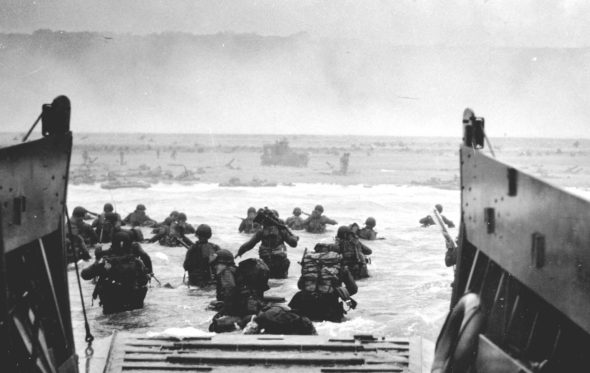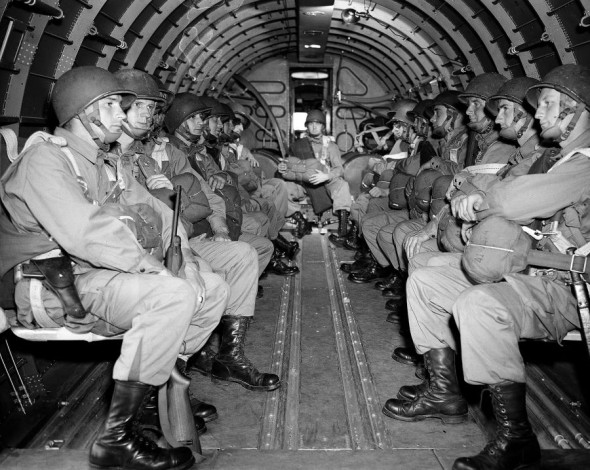D-day veterans find their bonds remain strong after 70 years
Daily News Article — Posted on June 6, 2014

Bill Millin playing the pipes for his fellow troops in 1944.
(by Steven Morris, The Guardian) – Some were old friends reunited once more to remember the horror they endured and the comradeship that kept them strong 70 years ago. Others were meeting for the first time and finding that, despite the passage of time, their shared experiences of D-day meant they had an instant bond.
British and American veterans of one of the greatest and most terrible of military operations gathered on Monday at Portsmouth Historic Dockyard. Almost 100-strong, they were invited aboard the last three D-day craft that are still operational and took part in a ceremony to honor the memory of Bill Millin, who played the bagpipes on Sword Beach to lift the spirits of allied troops as they waded ashore. They were treated to beef stew and mashed potato, washed down with American beer and British navy-issue rum.
Probably as important as the ceremonials was the chance to talk over the events of seven decades past. There were smiles, there was joking, but there were also tears.
British veteran Jim Baker was one of those determined to keep the mood upbeat. “At the age of 92, I’m too old for any [nonsense],” he said. Gesturing at a group of American veterans during a pause in the days’ proceedings, he added: “I used to curse at these guys; I used to call them all the names under the sun. But the truth is there aren’t any buggers better than this lot.”
Baker, a Royal Marine commando from Blackpool, was the coxswain on an LCA, the landing craft used to transfer troops from transport ships on to the beaches. He made the perilous journey on to Juno Beach 22 times on D-day.
He ferried in Americans who had had precious little contact with the sea. “They were prairie boys, they were scared of the water,” he said. “But when it came to it, they were braver than anyone. They may look a little past it now but they did the job back then. I’m proud to be associated with them.”
Baker’s point about age is a pertinent one. Almost all of those that were gathered in Portsmouth were in their 90s. Many used canes; some used wheelchairs; a few walked arm in arm to support each other.
Bob Powell, a 90-year-old from the city of Yakima in Washington state, was enjoying Baker’s memories. “I’ve never met him before but I may have been on that boat of his,” he said. How did he feel as he approached the beaches? “I was too dumb to know any better. I was 19. I had just got out of high school. I jumped off as soon as I could. There were ships everywhere, landing craft everywhere, machine gun fire, bodies floating past.”

D-day landing
Patrick Churchill, also 90 and another British commando, was taking the chance to thank the Americans he served with on D-day and the days and weeks that followed. “I do feel very thankful they were there,” he said. “They took some of the worst of it at places like Omaha and Utah [beaches]. They had a tough job and we should never forget that. But that’s not to say that everyone wasn’t important.
“Everyone was like a little cog in a giant machine. Without each and every cog, the machine just wouldn’t work.”
The vessels the veterans were able to inspect included Motor Gunboat 81, one of the lead boats for British and Canadian troops heading into Sword Beach. Also anchored at Portsmouth was Motor Torpedo Boat 102, which Churchill and Eisenhower used to review the fleet assembled for the D-Day invasion.
Following the day’s activities, most of the veterans were heading for France (by much more comfortable ferry) for this week’s anniversary ceremonies in Normandy. Steve Conyngham, 92, from Liverpool, has not been back since 1944 when he landed at Arromanches. “I never got the chance for one reason or another,” he said. “But I want to go before it’s too late.”
His memories are fragmented. “It was so confused. That’s what I remember most, the chaos. The memories have been coming back as I’ve got ready for this. I think it’s going to be emotional.”
Vern Ollar, 93, from Kerrville in Texas, was enjoying himself teasing the Scottish contingent for wearing kilts. “I like your skirt,” he told one. “I always thought you were the bravest, not only fighting but wearing those outfits.”
The sole woman veteran at this event, Vera Hay, 92, said humor was hugely important to all those who served during the second world war. “The good thing about these get-togethers is that you meet people who had the same sense of humor, the same sort of memories, the same experiences.”
Hay served with the Queen Alexandra Royal Army Nursing Corps and was landed in Normandy by Royal Marines where she helped treat injured troops. “It’s hard to explain to anyone who wasn’t there what it was like. When you’re together like this you can remember and you don’t have to explain.”
Reprinted here for educational purposes only. May not be reproduced on other websites without permission from The Guardian.
Questions
NOTE: “Answers” emails have ended for the school year and will resume September 2nd.
Daily posting will end for the summer on June 13th and will resume August 25th.
1. What was the significance of the Portsmouth Historic Dockyard for the WWII vets who gathered there the week before the 70th anniversary of the D-Day invasion?
2. Why was Bill Millin honored during a ceremony at Portsmouth?
3. How would you describe the tone of the British and American veterans quoted in this article?
4. How did the British veterans view the job the Americans did during the D-Day invasion?
5. What 2-3 adjectives would you use to describe these vets? Explain your answers.
6. Today’s Daily News Article is a human interest news story. Human interest stories differ from the regular news – they are sometimes referred to as “the story behind the story.“ The major news articles of the day tell of important happenings. Human interest stories tell of how those happenings have impacted the people or places around the story.
Do you think this human interest story is newsworthy? Why or why not?
7. Americans don’t place the same importance on the anniversary of D-Day that the British and French do. Should we? Explain your answer.
Background

American paratroopers sit inside a military plane as they soar over the English Channel en route to the Normandy French coast for the Allied D-Day invasion of the German stronghold during World War II, June 6, 1944. (AP Photo)
Normandy Invasion, June 1944 - Crossing the English Channel on "D-Day", 6 June 1944:
The English Channel, nearly a hundred miles wide between Portsmouth, England, and the Normandy beaches, was a formidible military barrier. Early in the previous century it had thwarted Napoleon. In 1940 it stopped the conquering Germans. Now, in the spring of 1944, the Allies needed thousands of ships and craft to transport their armies across the Channel and begin the liberation of France. To compound the difficulties of a long water passage, the always problematical weather could fatally disrupt landing operations, and the Germans had liberally planted sea mines in the central Channel and off likely invasion beaches.
A storm delayed the operation, originally scheduled for 5 June, after much of the invasion force had left embarkation points, forcing landing vessels back into port, where their crews and passengers endured the wait amid often crowded and uncomfortable circumstances. Presented with a better forecast for the sixth, General Eisenhower made a tentative decision late in the evening of 4 June to get shipping moving, and gave the final "O.K. We'll go." shortly after 4AM on the fifth.
By then, minesweepers were clearing shipping lanes through a fifteen mile wide southward path. Invasion shipping, nearly sixty separate convoys in the initial assault, with more behind, headed for the target area via a wide-topped "T"-shaped route, gathering off the Isle of Wight from various ports along England's southern coast, then turning south to cross the Channel in the recently swept lanes. Many vessels towed barrage balloons, protection against German bombing attacks that didn't come, since the enemy's weak air reconnaissance kept him ignorant of what was happening.
The passage across was anything but smooth, especially for infantry and tank landing craft, many of whose passengers suffered hours of seasickness during the night of 5-6 June. As the convoys approached Normandy, their courses flared out somewhat, taking them to staging areas off the individual landing beaches. Most ships were in their places well before dawn. Further inshore, the busy minesweepers continued their work, opening safe (or at least relatively safe) channels and working areas for landing boats and gunfire support ships.
Overhead in the darkness, a steady procession of hundreds of transport planes and gliders moved over Normandy, dropping U.S. paratroopers inland of the westernmost ("Utah") beach. British parachutists descended in the southeastern part of the assault zone. Behind the initial waves of ships and planes came more, in a flow that would continue for months to come, reinforcing the initial landings and providing logistics support for the armies as they consolidated their beachhead, broke out, and fought their way across northwestern Europe. (read more at: history.navy.mil/photos/events/wwii-eur/normandy/nor3.htm)
BAGPIPER BILL MILLIN: (from news.stv.tv/west-central/228556-d-day-piper-bill-millin-remembered-with-memorial-in-normandy)
- As personal piper to Lord Lovat and his 1st Commando Brigade, 21 year-old Bill Millin marched around Sword Beach after orders from his charismatic leader, who had defied a War Office ban on pipers.
- He played Highland Laddie and the Road to the Isles... After the battle, it is said German troops decided not to shoot at him on the beach, thinking he was insane.
- His actions were portrayed in the 1962 movie The Longest Day, starring John Wayne, Henry Fonda, Robert Mitchum and Sean Connery.
- Ian Macdonald is the Pipe Major of Jedburgh Pipe Band said of Bill Millin, “On D-Day, Lord Lovat said, ‘Come on Bill, give us a tune,’ when they were face down on the sand being shot at.
- “Bill said sarcastically to him, ‘Would you like to me to march up and down as well, sir?’ ‘He said, ‘Yes, that is great’. Bill jumped up and did it. You would never get people doing that now.
- “These guys don’t think it was special. They just think it was their job.
- “It is overwhelming. You read what these guys did for us and for the French. Here (in Normandy), Bill Millin is an absolute hero. The love for Bill Millin by the people of Normandy is unbelievable. He is a symbol of their freedom.”
